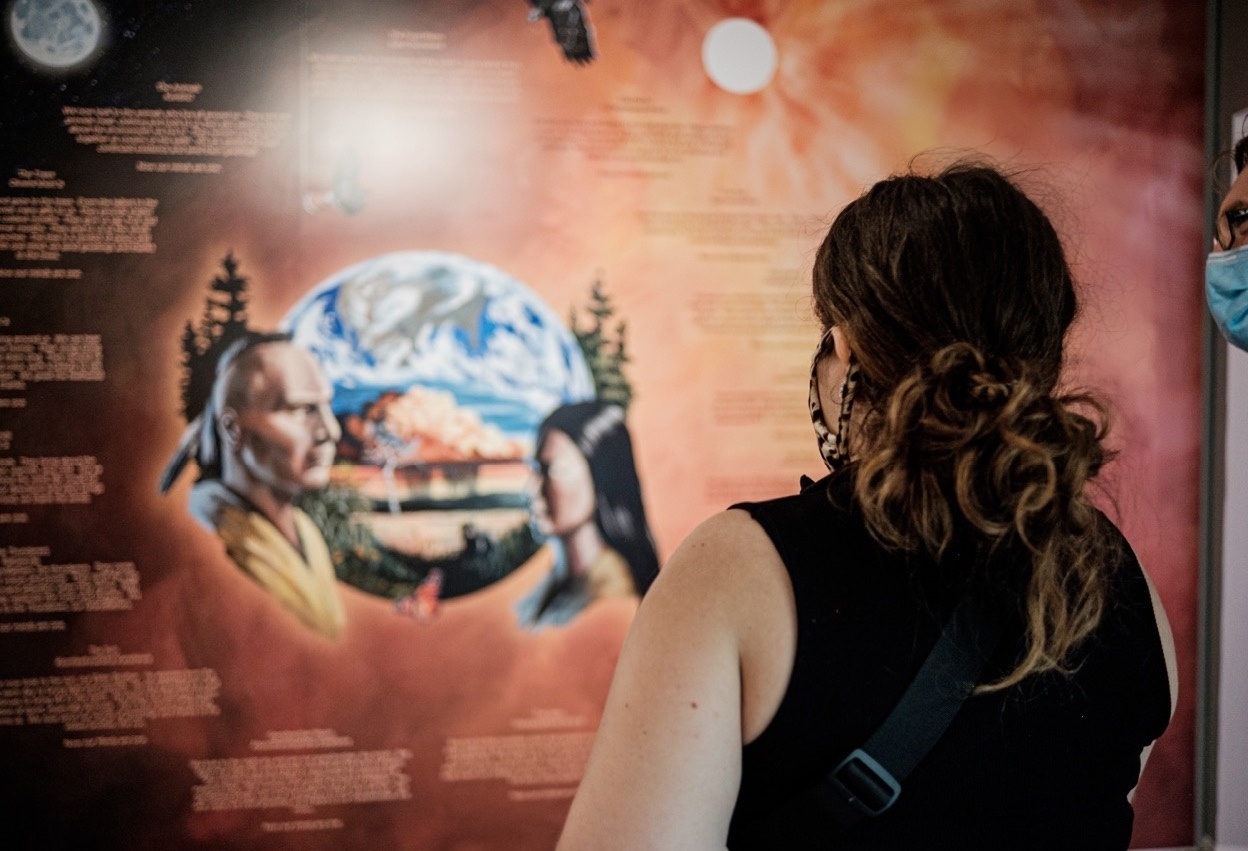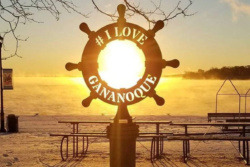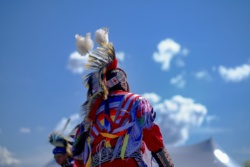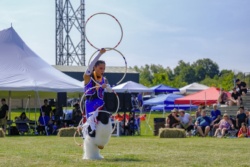
Honouring the Past, Embracing the Present: An Indigenous Cultural Journey
Honouring the Legacy of the Mohawks of the Bay of Quinte
Indigenous traditional knowledge passed on from one generation to the next would share that the islands and waterways in South Eastern Ontario have been part of Indigenous history since time immemorial. Today, the region provides several authentic ways to experience this Indigenous connection to the land and water and allows visitors to connect with the people and cultures that are woven into the very fabric of the land. Taking the time to learn from these communities, experience their culture, and learn their histories allows us as visitors to these lands to support our Indigenous partners and aid all of us on our journey of reconciliation.
To compensate for the loss of their traditional lands during the American Revolution and the signing of the 1738 Treaty of Paris and to acknowledge their loyal military support to the British Crown, the Six Nations (Mohawk, Oneida, Onondaga, Cayuga, Seneca Nations, and Tuscaroras) were granted the right to choose any unclaimed territory in Upper Canada. Consequently, the MBQ ancestors opted for lands along the northern shore of Lake Ontario for their new settlement. Their ancestors journeyed by canoe from Lachine, Quebec, and reached the shores of the Bay of Quinte on May 22, 1784. Around 20 families were welcomed by the Mississaugas who were present in the area. To honour this historic event, the community continues to commemorate the anniversary of the Landing with a re-enactment of their arrival and a thanksgiving ceremony celebrating their safe journey.
Start your journey. Unique Stays, Local Dining, and Cultural Experiences in Tydendinaga
Many of these locations operate seasonally, from May to October. Please check operator websites and links before you set out on your travels.
Check-in to your overnight accommodations at LiL Crow Cabins & Pods. These rustic cabins are tucked in right along the lakeshore, and provide an intimate getaway with multiple amenities to help you enjoy your stay. They have 4 unique cabin rentals to choose from and also feature the Eagle POD Gallery, which is the first of its kind and showcases the art creations and music of David R. Maracle (one of your hosts during your stay, along with his partner, KimberLee). Be sure to spend some time outside under the stars at their fire pit, enjoying the land and the sounds of the water.
The next morning, start your day with a coffee on the porch and get ready for your day. Stop by Deb’s Gas Bar and Restaurant located in Shannonville for an incredible diner breakfast to give you the fuel you need for your day. Their classic roadside stop features large, generous portions at any time of day, and it’s proudly opened and operated locally.
Then get geared up for your first activity of the day: a tour of the Tyendinaga Cavern & Caves system. Reservations made in advance are highly recommended for this experience as they guarantee you entry to the caves! Tours run every 30 minutes and are approximately 45 minutes long featuring the cave system itself as well as fossils dating back more than 450 million years. Your tour guide will also give you a history of how the caves were formed as well as the history of the area. This attraction also strives to offer a sustainable and ethical visitor experience, maintaining the integrity of the land and providing a natural habitat for local wildlife continues to be a main priority for the owners of the property.
Head back to the territory to do some shopping at locally owned establishments. Tyendinaga is home to a number of talented artists and entrepreneurs who operate galleries and storefronts for visitors to enjoy.
We recommend checking out:
- Native Renaissance located along Highway 49 in Deseronto has been operating for over 40 years and features an art gallery showcasing the work of Thomas B. Maracle, and a gift shop. The shop features a collection of hand-selected merchandise by Indigenous producers including leather moccasins, original and reproduction art pieces of Thomas B. Maracle, children’s clothes, and kitchen wares.
- Rebecca Maracle Gallery is the home gallery of Rebecca Maracle, a talented feathersmith, leatherwork, and beadwork artist. Her products for purchase include medicine pouches, earrings, bracelets, dream catchers, and framed featherwork pieces. She also practices traditional healing that promotes psychological and spiritual well-being through a variety of methods.
- Millside Ceramics was established in 1998 by Marleen Murphy. Her work features handcrafted earthenware clay and molds, and many of her pieces also feature soy and sweetgrass cedar wick candles that are also sourced from a local producer. Many of her pieces highlight the importance of the medicine wheel and feature items such as smudge bowls, night lights, incense holders, candles, ornaments, and more.
For dinner, head into Deseronto to the United Restaurant, where they serve up casual sit-down dining favourites, specializing in pizza, pasta, and panzerottis. Generous portion sizes and a friendly atmosphere make this place a must-visit for a taste of small-town hospitality at its finest. Head back to LiL Crow Cabins for the evening to rest up for your next days’ activities.
The next day, stop for lunch at Roadhouse 49 for some incredible homemade burgers and poutine using fresh-cut fries. Roadhouse 49 is a food truck, so it’s crucial to check their hours of operation depending on the time of year you’ll be visiting as they are not open in the colder months!
Discover Indigenous History and Art in Picton and Kingston
Head into Picton, located in Prince Edward County, to the Macaulay Heritage Park and the St. Mary Magdalene Church on the traditional territories of the Haudenosaunee, Anishinaabe, and Huron-Wendat. The church has been converted into a museum, and is now home to a permanent and evolving exhibit, “A Path Forward”. The exhibit speaks to the reconciliation efforts in the County and is co-curated with Tsi Tyónnheht Onkwawén:na Language and Cultural Centre in Tyendinaga Mohawk Territory, as well as the Gord Downie & Chanie Wenjack Fund. It features several works from Indigenous artists and offers a space for reflection, education, and guidance from the Indigenous community. Admission to the exhibit is by donation and is open to the public Wednesday through Sunday.
After “A Path Forward”, hop in your car and head East down the 401 corridor towards the City of Kingston. The area where Kingston is located has been inhabited by Indigenous Peoples for countless generations. The Anishinaabe, Haudenosaunee, and Huron-Wendat have all shared this land, following the principle known as "A Dish with One Spoon," which signifies the shared use of territory by different groups. Today, more than 7,000 residents in the region identify as First Nations, Inuit, or Métis. Historically, the northern shore of Lake Ontario was called Katarokwi, meaning a place of clay or limestone. The Algonquin word "Cataracoui," meaning "great meeting place," was adapted by the French into "Cataraqui," a name still commonly used in the Kingston area.
Off Highway 15 in Kingston you will find the All Our Relations Land Trust and their Indigenous Food Sovereignty garden. The garden was established in 2021 and is an Indigenous-led initiative with over 600 volunteers. The organization has planted over 1,000 native species of trees and shrubs, as well as a vegetable garden, a pollinator garden, and planted and harvested medicines. Be sure to check out their Facebook page for any upcoming events they may have during your visit through the area as they often have events where you can join them in the garden to plant, harvest, and learn the importance of the work they’re doing and the plants they’ve been cultivating.
Uncover Gananoque’s Rich History and Cultural Significance
Jump back in the car and head down the road just a bit further to Gananoque, Ontario. Of Indigenous origin, the name Gananoque has been interpreted in various ways. Some believe it means "Town on Two Rivers," referring to the St. Lawrence and Gananoque Rivers, while others translate it as "water flowing over rocks." According to local historian John Nalon, many associate the name with "the Place of Health." Each spring, First Nations would gather at the spot where the Gananoque River meets the St. Lawrence, basking in the sun and recovering from winter ailments such as scurvy. Grab some dinner at one of the many great places in Gananoque and spend the night at a local accommodation of your choice to rest up before continuing to Cornwall and Akwesasne the next day.
READ ALSO
Uncover the Stories and Cultural Legacy of Akwesasne
Arrive in Cornwall and check in to your accommodation at the Cardinal Inn. This red brick century home has been fully renovated and has 5 distinct and themed bedrooms for you to choose from and is centrally located for you to access all the amenities Cornwall has to offer. Cornwall itself is a short drive from Cornwall Island and home to the Mohawk Territory of Akwesasne. Their community spans all shores of the St. Lawrence River within two provinces (Ontario and Quebec) and two countries (Canada and New York, USA). Akwesasne means “the Land where the partridge drums”, referring to the rich and abundant wildlife in the area. We always advise on bringing your passport with you just in case when visiting the Island!
According to the oral history shared by their elders, the Mohawks of Akwesasne are descended from the original inhabitants known as the St. Lawrence Valley Iroquoians, who settled along the riverbanks thousands of years ago, long before the arrival of Europeans. The community's location on the mighty St. Lawrence River, with the Raquette and St. Regis Rivers also flowing through, made it an ideal home for their ancestors. These waterways were vital for transportation and trade, as well as providing a rich source of fish and game. The Haudenosaunee lived in longhouses up until the late 1800s. These structures were long, narrow, and covered in bark, with panels of elm bark lashed to wooden poles made from hickory, cedar, or elm. Traditionally, each village was organized by clan, and a matriarchal system meant that all women and children in a longhouse belonged to the same clan, while husbands and fathers came from different villages and clans. Today, Akwesasne welcomes visitors to share in the Mohawk Spirit. They provide several unique and enriching experiences that provide an introduction to Akwesasne life, history, art, and food.
When you wake up in the morning, grab some breakfast from Tilly’s Eatery and the Once Upon a Time Coffee Shop, where they serve up an epic selection of baked goods, hot beverages, and sandwiches. After breakfast, hop over to Cornwall Island and the community of Akwesasne. Your first stop will be the Native North American Traveling College. They offer tours of the museum which gives you access to the history of the community of Akwesasne and their stories. On display, you will find contemporary art, cultural relics, and historical presentations that highlight the history and culture of the people of Akwesasne.
Depending on the time of year of your visit, we recommend checking out the Thompson Island Cultural Camp. This eco-cultural camp will connect visitors with nature and the rich cultural history of Akwesasne and the Mohawk Peoples. Enjoy canoeing, medicine walks, exposure to traditional foods, and other cultural demonstrations while on the Island - you can even stay overnight! This experience is dependent on the time of year of your travel and ensuring that you pre-book your visit so that they can arrange a pick-up to get you to the island.
Akwesasne has many cultural tours available to experience during your visit to the community - we encourage you to check them out, but always be mindful of the location of the experiences depending on whether you’re travelling with a passport/visa or not!
READ ALSO
Sources for Indigenous history: Mohawks of the Bay of Quinte website and from articles produced for South Eastern Ontario by Trina Mather-Simard. More information on the Indigenous history of the Southeastern Ontario region can be found here.
READ ALSO


